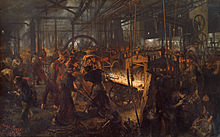Martha Morgan:A Journey to Zion
Story by Allen Morgan Kendall
Pictures added by Lois C. Berrett

The
Iron Mission
 The
trip to Salt Lake City may have begun more than the eternal continuation of
their marriage. To understand this, we must understand the Iron Mission. When
Apostle Parley Pratt led exploration far to the south of Salt Lake valley one
of the important discoveries made was that of iron ore. It provided an exciting
potential resource to a people striving to become independent of the iron products
being shipped at dear prices from the east. In 1851 a company of pioneers were sent
to what was then called Little Salt Lake Valley, 250 miles from Salt Lake
proper with the specific mission to establish an iron industry for the support
of settlements in the Great Basin and surrounding areas. The initial settlement
was Parowan, but
The
trip to Salt Lake City may have begun more than the eternal continuation of
their marriage. To understand this, we must understand the Iron Mission. When
Apostle Parley Pratt led exploration far to the south of Salt Lake valley one
of the important discoveries made was that of iron ore. It provided an exciting
potential resource to a people striving to become independent of the iron products
being shipped at dear prices from the east. In 1851 a company of pioneers were sent
to what was then called Little Salt Lake Valley, 250 miles from Salt Lake
proper with the specific mission to establish an iron industry for the support
of settlements in the Great Basin and surrounding areas. The initial settlement
was Parowan, but
Church in Parowan
the iron works were set up 20 miles to the southwest in Parowan. A fort
was built there called Fort Cedar, and it grew into the town of Cedar City. It
was selected because of coal to the east and iron ore to the west.

The
mission struggled valiantly from the beginning. Between snow and ice, drought,
Indian attacks, and poor quality coal, the production of usable iron seemed
nearly out of reach. But they persisted
for years. As late as June 1855, Pres. Brigham Young was still calling for
experienced European
iron workers to go to the Little Salt Lake Valley.26
This
may have prompted the Morgans to move there. During their visit to Salt Lake City
William may have received a call to serve in the coal mining operation when
Elder Pratt and
others were reminded of his experience. Or he may have been persuaded by
brother in law Andrew
Patterson, who was already serving there. One thing is certain, there was
little personal advantage
to their family. They were probably looking forward to settling permanently in
Nephi with
the dream of a little farm of their own at the base of majestic Mount Nebo. The
move to Cedar
City was a call to duty, a faithful response to the consideration of the sacred
covenants they
had just made.
The
Morgans were in Cedar City by 1856. Their presence there was again marked by
the birth and
death of another child. Thomas William Morgan, less than 6 months old, died
there on 20 September
1856.27
.png) Drought and grasshopper
infestation in 1856 began a serious decline in the operation. The
Utah War in 1857 sounded the death knell for the iron works with its disruption
and draw upon
resources. The tension in the area was further increased by the Mountain
Meadows Massacre in September of 1857. The operation finally closed in 1858.28
Drought and grasshopper
infestation in 1856 began a serious decline in the operation. The
Utah War in 1857 sounded the death knell for the iron works with its disruption
and draw upon
resources. The tension in the area was further increased by the Mountain
Meadows Massacre in September of 1857. The operation finally closed in 1858.28
From
a practical perspective, the Iron Mission was a failure. But for the Morgan
family and the others
who sacrificed greatly in this effort much more than iron was produced in the
fiery furnace which burned there. Once again the character of the saints who
gave much was forged to a more perfect form in a test which could have made
them or broken them. The cooperative operation
of the church functioned throughout their time there. In 1856 a Female
Benevolent Society (Relief Society) was
organized in Cedar City. Martha Morgan would have been a part of it. Martha gave birth to a healthy son there, on 1 Oct 1857, and named him in honor of her father Edward Nelson Morgan.29
organized in Cedar City. Martha Morgan would have been a part of it. Martha gave birth to a healthy son there, on 1 Oct 1857, and named him in honor of her father Edward Nelson Morgan.29
26.
Shirts, Morris A. A Trial Furnace. Brigham Young University, University Publications. 2001.
27.
LDS Church Membership Records.
28. A Trial Furnace.
29.
LDS Church Membership Records.


No comments:
Post a Comment
Note: Only a member of this blog may post a comment.